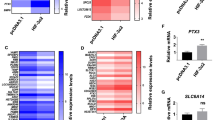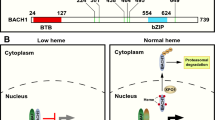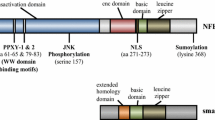Abstract
We examined regulation of the human erythropoietin (Epo) gene through the GATA sequence in the Epo promoter, and demonstrated that Hep3B and HepG2 cells express human GATA-2 (hGATA-2) mRNA and protein. Nuclear extracts of QT6 cells transfected with hGATA-1, 2 or 3 transcription factors revealed specific binding to the GATA element in the human Epo gene promoter by gel mobility shift assay. Transient transfection of Hep3B cells with hGATA-1, 2 or 3 demonstrated that each of these transcription factors significantly decreased the level of expression of Epo mRNA as assessed by a competitive polymerase chain reaction (PCR). Furthermore, transient transfection of Hep3B cells with hGATA-1, 2 and 3 and an Epo-reporter gene construct showed significant inhibition of the Epo promoter. We conclude that the hGATA-1,2 and 3 transcription factors specifically bind to the GATA element in the human Epo gene promoter and negatively regulate Epo gene expression.
Supported by grants-in-aid for scientific research from the Ministry of Education, Science and Culture of Japan, the Uehara Memorial Foundation, the Yamanouchi Foundation, the Ichiro Kanehara Foundation and the Chugai Foundation.
Access this chapter
Tax calculation will be finalised at checkout
Purchases are for personal use only
Preview
Unable to display preview. Download preview PDF.
Similar content being viewed by others
References
Graber SE, and Krantz SB: Erythropoietin: Biology and clinical use. Hematol. Oncol. Clin. North Am.3: 369, 1989
Goldwasser E, Jacobson LO, Fried, W, Plzak, L.F: Studies on erythropoiesis. V. The effect of cobalt on the production of erythropoietin. Blood13: 55, 1958
Goldberg MA, Glas, GA, Cunningham JM, Bunn HF: The regulated expression of erythropoietin by two human hepatoma cell lines. Proc. Natl. Acad. Sci. U.S.A.84: 7972, 1987
Goldberg MA, Dunning SP, Bunn HF: Regulation of the erythropoietin gene: Evidence that the oxygen sensor is a heme protein. Science242: 1412, 1988
Imagawa S, Izumi, T, Miura Y: Positive and negative regulation of the erythropoietin gene. J. Biol. Chem.269: 9038, 1994
Aird WC, Parvin JD, Sharp PA, Rosenberg RD: The interaction of GATA-binding proteins and basal transcription factors with GATA box containing core promoters. J. Biol. Chem.269: 883, 1994
Gilman M: Current Protocols in Molecular Biology, Wiley Interscience, New York, 1988, Vol. 1, p 4.1.4
Riddle RD, Yamamoto M, Engel JD: Expression of δ-aminolevulinate synthase in avian cells: Separate genes encode erythroid-specific and non specific isozymes. Proc. Natl. Acad. Sci. U.S.A. 86: 792, 1989
Yang Z, Gu L, Romeo P-H, Bories D, Motohashi H, Yamamoto M, Engel JD: Human GATA-3 trans-activation, DNA-binding, and nuclear localization activities are organized into distinct structural domains. Mol. Cell Biol.14: 2201, 1994
Imagawa S, Goldberg MA, Doweiko J, Bunn HF: Regulatory elements of the erythropoietin gene. Blood77: 278, 1991
Costa-Giorni P, Caro J, Weinmann R: Enhancement by hypoxia of human erythropoietin gene transcription in vitro. J. Biol. Chem.265: 10185, 1990
Yamamoto M, Ko LJ, Leonard MW, Beng H, Orkin SH, Engel JD: Activity and tissue-specific expression of the transcription factor NF-E1 multi gene family. Genes & Dev. 4: 1650, 1990
Neumann JR, Morency CA, Russian KO: A novel rapid assay for chloramphenicol acetyltransferase gene expression. BioTechniques5, 444, 1987
Beck I, Ramirez S, Weinmann R, Caro J: Enhancer element at the 3’-flanking region controls transcriptional response to hypoxia in the human erythropoietin. J. Biol. Chem. 266: 15563, 1991
Pugh CW, Tan CC, Jones RW, Ratciffe PJ: Functional analysis of an oxygen-regulated transcriptional enhancer lying 3’ to the mouse erythropoietin gene. Proc. Natl. Acad. Sci. U.S.A.88: 10553, 1991
Semenza GL, Nejfelt MK, Chi SM, Antonarakis SE: Hypoxia-inducible nuclear factors bind to an enhancer element located 3’ to the human erythropoietin gene. Proc. Natl. Acad. Sci. U.S.A.88: 5680, 1991
Semenza GL, Wang GL: A nuclear factor induced by hypoxia via de novo protein synthesis binds to the human erythropoietin gene enhancer at a site required for transcriptional activation. Mol. Cell. Biol.12: 5447, 1992
Beck I, Weinmann R, Caro J: Characterization of hypoxia-responsive enhancer in the human erythropoietin gene shows presence of hypoxia-inducible 120-kd nuclear DNA-binding protein in erythropoietin-producing and nonproducing cells. Blood82: 704, 1993
Blanchard KL, Acquaviva AM, Galson DL, Bunn HF: Hypoxic induction of the human erythropoietin gene: Cooperation between the promoter and enhancer, each of which contains steroid receptor response elements. Mol. Cell. Biol.12: 5373, 1992
Madan A, Curtin PT: A 24-base-pair sequence 3’ to the human erythropoietin gene contains a hypoxia-responsive transcriptional enhancer. Proc. Natl. Acad. Sci. U.S.A.90: 3928, 1993
Galson DL, Tsuchiya T, Tendler DS, Huang LE, Ren Y, Ogura T, Bunn HF: The orphan receptor hepatic nuclear factor 4 functions as a transcriptional activator for tissue-specific and hypoxia-specific erythropoietin gene expression and is antagonized by EAR3/COOP-TF-1. Mol. Cell. Biol.15: 2135, 1995
Author information
Authors and Affiliations
Editor information
Editors and Affiliations
Rights and permissions
Copyright information
© 1996 Plenum Press, New York
About this chapter
Cite this chapter
Imagawa, S., Yamamoto, M., Miura, Y. (1996). Gata Transcription Factors Negatively Regulate Erythropoietin Gene Expression. In: Abraham, N.G., Asano, S., Brittinger, G., Maestroni, G.J.M., Shadduck, R.K. (eds) Molecular Biology of Hematopoiesis 5. Springer, Boston, MA. https://doi.org/10.1007/978-1-4613-0391-6_61
Download citation
DOI: https://doi.org/10.1007/978-1-4613-0391-6_61
Publisher Name: Springer, Boston, MA
Print ISBN: 978-1-4613-8031-3
Online ISBN: 978-1-4613-0391-6
eBook Packages: Springer Book Archive




